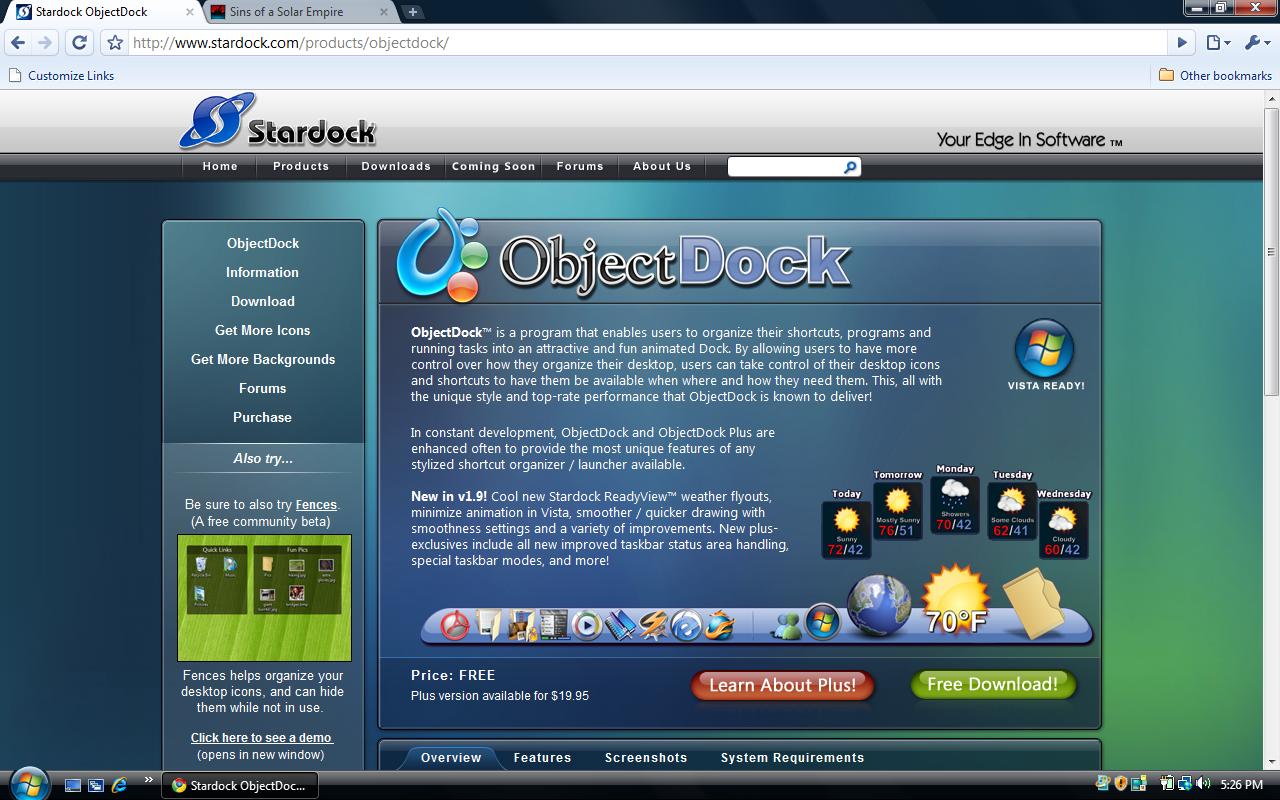
Objectdock Stack Docklet
THIS TUTORIAL INVOLVES: • Docking program (tested on Rocketdock and Objectdock) • Stack docklet (I use on both RD and OD) • Please choose the appropriate version for your OS. • 64-bit programs with troublesome shortcuts ***** Since you're reading this, this author assumes that you already have Stacks docklet installed and have been using it for quite some time now. You are just annoyed why 64-bit program shortcuts give you error everytime you access it inside the Stack. Therefore, THIS TUTORIAL IS NOT ABOUT: • Installing Stacks docklet • Creating stacks ***** INTRO 64-bit application shortcuts are not easy to tame, especially when you use Stack docklets to collect them in groups. Some shortcuts work (in my case, Photoshop has been friendly), but most of the time they appear as this ugly icon: And when you click it, a dialog will popup to tell you that it can't be opened: A workaround to make 64-bit applications shortcuts accessible via the Stacks docklet was provided in Aqua-Soft forums. Their instruction, though good, is too technical and time-consuming.
THIS TUTORIAL INVOLVES:Docking program (tested on Rocketdock and Objectdock) Stack docklet (I use Stack Docklet For ObjectDock by ~arshi2009 on deviantART on both RD and OD) Link Shell Extension Pleas. Tutorial on getting the stack docklet feature on leopard for windows object dock once in a blue moon the.
But I'm a newbie and I want an easy way out. So for those having trouble with creating symbolic links, here's a quick tip. 1) download and install Link Shell Extension. The software will add a context menu item. 2) Go to C: Program Files and select the folder of the 64-bit program you'd like to include in Stacks docklet. (In this example, I will use 7-zip) 3) Right-click on the folder and select Pick Link Source 4) Then, create a folder anywhere. But I advise that this folder should contain symbolic links ONLY so they remain organized.
(In my case, I put all my symlinked folders in D: Apps SymLinks where it sits nicely with my D: Apps Shortcuts folder so they're easier to reference in case I needed to change something). 5) Open that newly-created folder. Right-click anywhere, and select Drop As then Symbolic Link. (The item you just 'dropped' will now appear in that folder and it has a green overlay icon to indicate that it's a Sym Link ( CAUTION: If you have MS Office Groove installed, the extra overlay icons added by Link Shell Extension won't behave nicely). Ukrainskij voyazh 2013 sbornik torrent. Here's a quick explanation of the difference between a linked folder (normal shortcut) and a symlinked folder: -Normal shorcut is like riding an elevator: it will transport you from floor A to floor B -Symlink meanwhile acts like having a front door (original source) and backdoor (symlinked destination): no matter which one you choose you'll still be able to enter the house Therefore, the 'dropped' folder will behave as if it originally resides in the location you put it in. It won't affect the size of your disk but any changes you make in that folder, be it the original or the symlink, will reflect one and the other.
So it's better to leave it alone unless you know what you're doing.) 6) Open the folder you just 'dropped'. Find the program's main.exe file that launches the program and create a shortcut for it.
7)This newly-created shortcut is what you should use in your Stacks docklet. Teatraljne mistectvo yapon prezentacya. After creating your docklet that include this shortcut, you should be able to see the proper icon of your 64-bit program and click on it. ***** This is my very first tutorial, so sorry for being sloppy. Hope this helps someone. This can be accomplished in a slightly simpler way. You do not have to create symbolic links for each application. Instead, create a symbolic link to the 64-bit 'Program Files' folder so that 32-bit applications can 'see' it.
Then modify your plain old windows shortcuts to touch this new 'folder' instead of the original 'Program Files' folder. 1) Open a command prompt 2) Type: mklink /j 'C: Program Files (x64)' 'C: Program Files' 3) Build your regular windows shortcuts using the C: Program Files (x64) directory rather than the C: Program Files directory. Computer type PC/Desktop System Manufacturer/Model Number HP-Pavilion-a6000-Desktop-PC OS Microsoft Windows 7 Professional Edition Service Pack 1 (build 7601), 64-bit CPU Intel(R) Core(TM)2 Quad Q9550 @2.83GHz (Xeon) Socket 775 LGA Motherboard ASUSTeK Computer INC. Benicia (P35/G33/G31) Memory 4095 MB (4 x 1024 MBytes DDR2 Dual Symmetric) Graphics Card Sapphire HD 7770 GHz Edition (shows Radeon R7 200) Sound Card Realtek High Definition Audio Driver Version 6.0.1.6662 Monitor(s) Displays HP w19b 18.6' 5:3 (SN: CNC703PN1G) Screen Resolution 1440 x 900. Keyboard Logitech G110 Mouse Logitech G500s PSU GX750 Case Black/Blue APEVIA X-Hermes Cooling 2 Top, 1 back, 1 front fan all 180 mm & side 200mm Hard Drives 1080 GB total C: (320Gb): WDC WD3200AAKS-75L9A0 ATA D: (Optical Drive): ATAPI DVD A DH16A6S ATA Device E: (1Tb): WDC WD10EARS-00S8B1 ATA F: (Backup 2 Tb): Clikfree Backup Drive USB Internet Speed High speed cable Antivirus Avast! Internet Security 2014.9.0.2021 Browser Firefox 44 (x86 en-US) Other Info BIOS American Megatrends Date: 09/10/09 10:25:18 Ver: 5.43. I had the same problem with Stack Docklet, and I found a simple way to fix it!:) The problem is because of a 'bad' structure in some shortcuts that Stack Docklet fails to interpret correctly.